Table of Contents
EVO: Engine Mechanicals - Sub-03F
Measuring Cylinder Bore
Straightness and Roundness of OEM Cylinders
Article by aswracing of the XLForum. 1)
This applies mainly to factory HD cylinders. And it is meant as an example between production cylinders and aftermarket cylinders with a “hands on” machinist.
The factory cylinder is a production line piece. Like all manufacturing, the idea is to deliver something that works at the lowest cost possible.
But when you rebuild a motor, or convert an 883 to a 1200, you have opportunities to do things better than the factory did.
This is one of those opportunities. There are several others. It's really no different in the world of cars.
A good machinist can always get things a whole lot better than typical production line stuff.
It is not a highly unusual result (for stock cylinders to be out of round).
I've seen worse in fact, and I've seen better, too. It's something of a crap shoot when you grab a production cylinder.
Might be good or bad or anywhere in between, you don't know unless you measure. In all fairness to HD, some things need to be noted here:
- The spigot is really hard to get straight. But no way should it be anywhere near 8 thou off. Maybe 1 thou.
- The other cylinder of this set was only about half a thou (5 tenths) total out of round until the spigot and then it was about a thou out.
It was definitely a better than average factory cylinder. - The type of torque plates used and the way in which it's tightened also have an effect. It's not a totally repeatable process.
I can make a cylinder perfectly straight and round, take it out of the torque plate and it'll be distorted as hell.
Put it back in the torque plate and it'll be close to what it was when I machined it, but not exactly the same.
A few tenths off here, a few tenths off there. But this cylinder's distortion is way beyond the repeatability of the measurement.
(From the results below) I hope y'all understand where I'm coming from when I say you're better off to get your OEM cylinders bored and honed than to buy new OEM ones.
There may not be much difference in cost, but there can be a huge difference in quality.
And this is an area that really matters for both the power and longevity of your motor. Just make sure the shop you have do the boring knows what they're doing.
Getting a cylinder straight, round and perfectly sized for the correct clearance takes a bit of skill.
And don't even think about measuring or machining a cylinder without torque plates.
It ain't even worth your time to stick the bore gauge in it, it'll change so much.
If a shop tells you they can measure or machine them without torque plates, run, don't walk, away.
A well designed, hefty aftermarket cylinder (i.e. Axtell) will change only slightly in and out of a torque plate.
A factory cylinder will move a mile. They're flexi-flyers.
Actual phone conversation I had once:
Customer: Just got my cylinders back and they don't measure right.
Me: What kind of torque plates did you use?
Customer: What kind of what?… (followed by a long conversation explaining how bad a factory cylinder distorts and how essential the torque plate is).
Today I took some pictures of a new take-off stock cylinder, as we did some measurements on it. What we did is measure this cylinder in 1“ depth steps.
We did the measurement both in the thrust direction and 90 degrees to that direction at each depth.
You do it this way to show out of roundness. Really, four postions is better than two. But two will get the point across with less complication here.
The dial bore gauge shows a relative measurement. Don't try to figure out bore size from it's reading.
Each numeral on the dial is .001”, which we normally call a “thou”. It has ten little lines between each numeral, each representing .0001“ (AKA “tenth”).
It's a tenth of a thou and thousandths is always our default unit of measure.
So anyway, here's what we got, again, with a new take-off stock cylinder:
One inch down. Very little out of round, maybe a couple tenths.
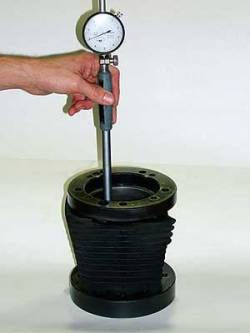
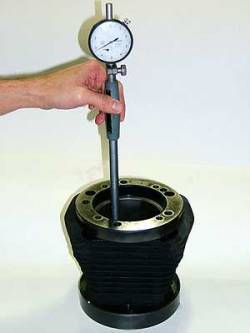
Two inches down. About 8 tenths out of round. Hmm, not good.
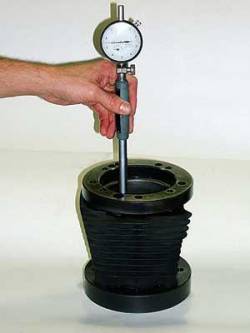
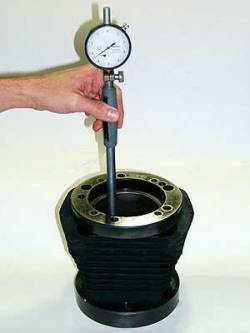
Three inches down. Yikes, 3 thou out of round. This is bad, very bad.
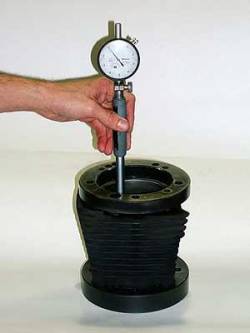
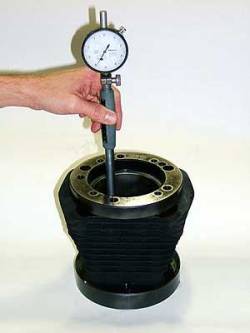
Four inches down. We're into the spigot, which has no material backing it up and is very prone to distortion.
We're literally 8 thou out of round down here. Holy smokes.
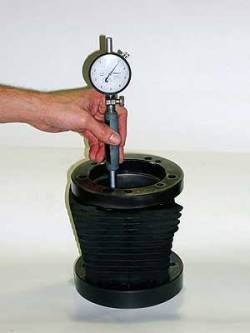
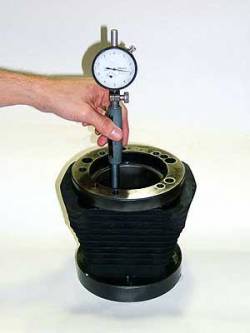
I should point out, too, just how bad these numbers are.
With the cylinder this far out of round, you're basically asking the rings to change shape as they go down the bore.
That's not going to happen to a very large extent at all. Instead they're going to leak.
On top of that, consider that a cast piston is designed to be fit to about a .001” clearance in the bore.
Forged pistons are typically .002“ to .003” depending on the application. Too tight will cause scuffing, too loose will cause piston rock and poor ring seal.
So with a cylinder that' s this crooked, how do you get the right clearance? On what measurement do you base your clearance? It's kinda ridiculous.
(So called) “seasoning” that people talk about is real.
It's been a long time since I had any metallurgy instruction so I can't explain it, but I can tell you I can sure as hell measure it.
I really notice it on connecting rods. Take a perfectly round big end and put it together. Pull it out in 10K miles and it'll be out of round.
Now lap the races and resize it and put it back together. Take it apart in another 10K miles and voila, it's still round.
That happens with cylinders, too. They seem to distort some during break in. Pull'em out, bore & hone'em, get'em perfectly straight, and then they tend to stay straighter.
The factory cylinders have very little aluminum backing up that liner. They twist and distort like crazy.
The iron cylinders are amazingly stiff, but even the aluminum jobs are better than the factory pieces. On the 883 or 1200 cylinder, it makes little difference.
